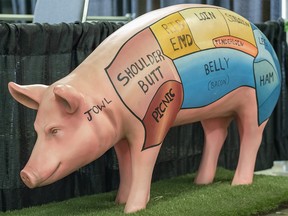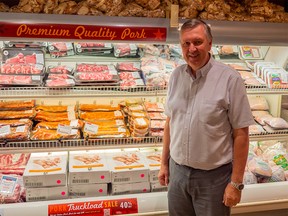
Source: Calgary Herald
Producers are losing more than $40 per pig despite an increase in supermarket prices due to rising costs and shrinking price share.
“We cannot survive taking a $40 loss per pig for the rest of the year,” said Martin Waldner, barn manager near Bashaw which is run by 20 families on the Hutterite colony.
“I don’t think I have the words today to explain how frustrated I feel some days when I get up in the morning and think about the losses that we are incurring every day.”
For Hartland, it’s not a facilities issue — those were constructed in 2007 with a 40-year lifespan. It’s not a quality issue — they produce some of the best pork in Canada, shipping much of it to Japan which has some of the highest standards in the world.
They have seen their per unit cost increase by $100 a pig, while market prices have not kept up with the inflation that has hit everything from utilities and fuel to insurance, feed and medical bills. Even when the prices increase, it is not near enough to cover their losses, and the frustration grows with a large markup of pork on the retail end that does not trickle back to the producer.ntario, M4W 3L4 | 416-383-2300
In an effort to adjust to the challenges, they have already scaled back their production from about 21,000 pigs to 16,000 annually.
They are not alone in their struggles.
Canada is also a much smaller factor in the market than some of the competition, but due to the quality of pork is able to be a player in some Asian markets.
Olymel is facing additional large-scale labour issues and the waning prices led to $350 million of red ink the last year — the bulk of it due to their pork business.
Depending on the market price, Olymel is losing between $40 and $75 per pig, partly due to increased transportation costs.
“The hog price is going to go down through the winter here — typically our lows are in December — and we’re just not seeing the price relief right now,” said Casey Smit, vice-president of swine production.
Olymel is pushing for adjustments to AgriRecovery that would lift the $3-million cap as well as other cost relief to ensure producers are able to hang on through the transition.

‘We can’t do this anymore’
Darcy Fitzgerald, executive director of Alberta Pork, said they have lost 20-25 major commercial producers over the last five years with potentially another 15 on the way out. This will add up to a decrease of 500,000 pigs produced annually from previous levels of three million.
“Some of these are third, fourth generation farms, they’re just saying, ‘You know what, we can’t do this anymore,’” he said.
This will ripple out off the farm and impact the entire agribusiness sector.
Ray Price, president and CEO of Sunterra Group, said market prices have improved the past couple of weeks for pigs, but “it has been a tough 12, 14, 16 months.”
Sunterra has been in operation for 50 years near Acme, less than an hour north of Calgary, and has expanded to include a processing facility near Trochu, additional farms in South Dakota and Iowa, a cropping division and greenhouse, and eight retail outlets in Calgary and Edmonton.
They are also the main processor for Hartland among others. Much of what flows through their facilities heads to Japan. But their processing has dropped 60 per cent this year over last due to issues with the Japanese economy.
“We’ve relied on agriculture exports a lot from a Canadian GDP economy, especially in Western Canada,” he said. “And every pound that is not sold or every kilo that’s not sold to the export market is less GDP in the ag industry and less value added.”

‘The hog industry will bounce back’: expert
Sylvain Charlebois, senior director of the Agri-Food Analytics Lab at Dalhousie University in Halifax, said a downsizing of the industry in Canada is necessary at this time due to export demand.
This means more pain is likely coming for producers, but it will rebound.
“There’s no doubt it’ll all get smaller,” he said. “We’re going through a recalibrating phase and that’s due to what’s going on around the world. The hog industry will bounce back … so I’m not overly concerned. We’re not going to lose the hog industry, even if governments don’t step in.”
He noted Canadian producers have been their own worst enemy at times, selling swine genetics to other countries over the last 30 years which has undercut the demand for the quality of Canada’s pork.
Despite all of this Fitzgerald remains confident these issues in time will be figured out.
“We’re always hopeful that we’re going to turn it around,” he said. “(Producers) are always trying to be optimistic and make sure that something better will come along. I think as the number of animals drop … we will see that change happen. I think 2024 we’re gonna see some swing around.”





